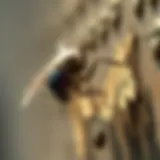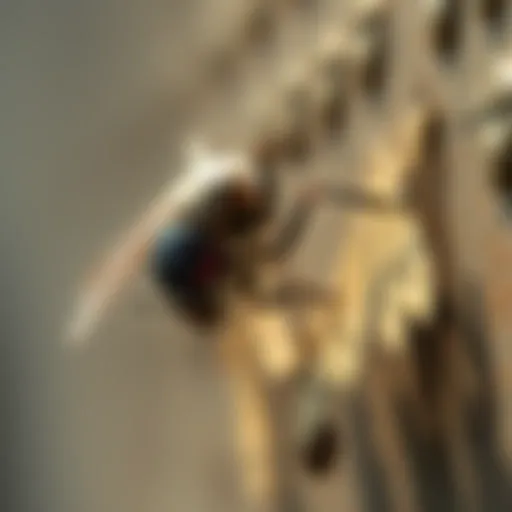Understanding Wood Roaches and Home Infestation Risks
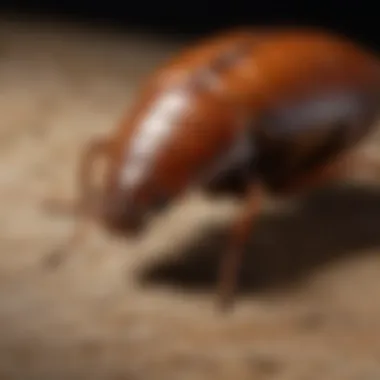

Intro
Wood roaches, often viewed as mere nuisances, play a significant role in the ecosystem yet can become a real headache when they venture into domestic spaces. Understanding these pests—their habits, habitats, and how they can infiltrate our homes—is crucial for homeowners and tenants alike. By recognizing what wood roaches look like and noting the signs of their presence, one can take early action, potentially preventing bigger problems down the line. This article takes a closer look at wood roaches, focusing on their identification, prevention measures, and control options available for those who find themselves dealing with these unwelcome guests.
Pest Identification
Common Household Pests
When it comes to household pests, wood roaches are often mistaken for other cockroach species. Identifying a wood roach hinges on a few distinguishing traits. Adults are typically brown with a body length of about 1 to 1.5 inches. They possess long, slender antennae, and while they have wings, they are not strong fliers. Their preferred habitats are damp locations like wood piles, basements, or stumps.
For comparison, common household cockroaches such as the German cockroach or American cockroach may also invade homes, yet they exhibit different preferences for temperature and are often more active indoors.
Signs of Infestation
Detecting the presence of wood roaches can be tricky, but a few indicators stand out:
- Droppings: Look for small, dark pellet-like frass. This evidence suggests roaches have made your home their own.
- Shed Exoskeletons: As wood roaches mature, they shed their skin. Finding these skins can signal a growing problem.
- Live Specimens: Spotting a few live wood roaches, especially near moisture-rich areas, can indicate that these pests are occupying your space.
"An ounce of prevention is worth a pound of cure." Recognize these signs early to keep wood roaches at bay.
Prevention Methods
Environmental Modifications
To deter wood roaches, consider altering your environment:
- Reducing Humidity: Since these roaches thrive in moisture, using a dehumidifier in damp areas or fixing leaks can significantly reduce the chances of an infestation.
- Managing Vegetation: Keeping wood piles away from the foundation of your home and maintaining your garden can help minimize inviting habitats for these pests.
Home Maintenance Tips
Regular home maintenance can also act as a strong line of defense:
- Sealing Cracks: Inspect doors, windows, and other entry points for cracks or crevices. Seal them well to fend off potential roaches.
- Routine Cleaning: Regular vacuuming and cleaning, especially in dark or hidden places, can reduce the likelihood of attracting wood roaches or other pests.
DIY Pest Control Solutions
Natural Remedies
Many homeowners prefer natural methods to control wood roaches. Some effective remedies include:
- Boric Acid: Sprinkling boric acid in areas where you suspect roach activity can deter them, as it is deadly to pests but generally safe for humans and pets.
- Essential Oils: Peppermint or tea tree oil can serve as natural repellents. Mixing a few drops with water and spraying in infested areas may help keep pests away.
DIY Traps and Barriers
Creating your own traps might help to catch wood roaches before they become a bigger issue:
- Jar Traps: Place a jar with a bit of water inside. Set an oil or grease coating around the rim—this can trap roaches if they slip inside while trying to access something attractive nearby.
- Boric Acid and Sugar Mix: Combining boric acid with sugar creates a bait that is enticing but deadly for wood roaches. Just be cautious to keep this away from children and pets.
Foreword to Wood Roaches
The topic of wood roaches holds considerable relevance for homeowners and those who maintain a keen eye on pest management. Understanding these insects is crucial because they can often be confused with more notorious pests, leading to unnecessary panic and misidentification. Wood roaches, while they may not carry the same reputation as their household counterparts like the German cockroach, still warrant attention due to their potential to invade residential spaces, especially in areas with particular environmental conditions.
Getting acquainted with the characteristics of wood roaches lays the groundwork for effective prevention and control strategies. Knowing what these bugs look like and their behavioral patterns can save homeowners from repeated infestations. This article aims to share insights about wood roaches, exploring their habitat, behaviors, and signs of infestation. It also delves into effective prevention strategies to keep these roaches at bay.
Defining Wood Roaches
Wood roaches belong to a group of cockroaches known as Parcoblatta. They typically thrive in wooded areas and are often found outdoors. Characteristically, these roaches are not primarily household pests, although they can wander into homes, especially during summer when they are searching for moisture and food. Their body is somewhat flattened and oval-shaped, with a significantly sleek appearance. Most wood roaches exhibit a light to dark brown coloration, making them blend well with natural settings.
The lifecycle of wood roaches offers insight into their behavior. Their development stages include eggs, nymphs, and adults, with nymphs resembling small versions of adults but without wings. So when one encounters one of those small insects in their gardens or backyards, there’s a strong chance they could be wood roaches.
Common Species of Wood Roaches
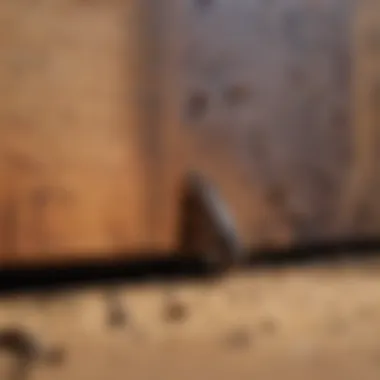

Several species of wood roaches exist, some more commonly seen than others. Notably, the Pennsylvania wood roach and the American wood roach deserve special mention because of their prevalence in various environments, particularly around homes. Understanding the specifics of these species can provide further context for discussions about infestation risks and management.
Pennsylvania Wood Roach
The Pennsylvania wood roach (Parcoblatta pennsylvanica) is one of the more common species encountered in residential areas. A distinctive feature of this wood roach is its capability to fly. Though usually shy and preferring wooded areas, they may venture into homes if attracted by light or moisture. Their presence in residential settings is often temporary, especially during warmer months.
What makes this species beneficial in the context of this article is its fact that it is generally harmless and unlikely to cause significant property damage or health risks. However, their natural hunting instinct means they might feed on decaying plant material, which can be a double-edged sword. They aid in breaking down organic waste but may invade homes searching for moisture and food.
American Wood Roach
The American wood roach (Parcoblatta americana) is another key species worth noting. Slightly larger than its Pennsylvania counterpart, it frequently appears in various habitats. A notable feature of the American wood roach is its darker, more robust appearance. They often seek shelter in damp areas, making bathrooms and basements potential hotspots of activity.
In terms of behavior, this species tends to be more resilient to environmental changes, allowing it to thrive in various situations. This resilience puts it on the map as a significant player in discussions about wood roach infestations. Understanding this species allows homeowners to identify and manage potential risks more effectively.
Other Notable Species
Among the other less prominent yet relevant members of this group include species such as Parcoblatta fulvescens. These wood roaches might not be as well-known, but they still play a role in regional ecosystems. Each has unique characteristics, such as a more centralized habitat preference or varied food sources. Collectively, their behaviors impact how homeowners might encounter wood roaches. Understanding these variations deepens our comprehension of potential infestations and guides management practices.
Habitat and Behavior
Understanding wood roaches is more than just picking apart their physical traits; it’s crucial to explore their habitat and behavior. These aspects reveal how these pests adapt to their surroundings and how they might encroach upon residential areas. Recognizing the natural preferences and behavioral patterns of wood roaches allows homeowners to anticipate potential problems and proactively address them.
Natural Habitat Preferences
Wood roaches prefer living in naturally humid environments, often found under logs, in decaying wood, or within leaf litter. They thrive in outdoor settings where moisture is plentiful, which is essential for their survival. Areas like forests, wooded regions, and even some gardens create a perfect haven for them. Understanding where these critters are most comfortable can be invaluable, as it indicates where to look for potential infestations if they venture indoors.
Key Highlights:
- Moisture: Their affinity for damp places means that basements and crawlspaces in homes can quickly become attractors if not properly managed.
- Shelter: They seek refuge in dark, undisturbed locations. This knowledge underscores the need for regular home inspections in these hidden areas.
Behavioral Patterns
Behavior showcases how wood roaches interact with their environment. This includes their feeding habits, mating behaviors, and overall activity levels. By dissecting these patterns, we gain insight into their life cycles and how they might influence the decision-making process of homeowners.
Feeding Habits
Wood roaches are omnivorous, enjoying a diet mainly comprising decaying plant material, fungi, and even other organic matter often found in their habitat. This aspect of their behavior is significant as it affects not only their survival but can lead to secondary problems indoors. Should they infest a home, the remnants of their feeding can compromise food stores and attract secondary pests.
- Diversity in Diet: Their preference for decaying matter makes areas with poor cleanliness more prone to infestations.
- Practical Concerns: Knowing what they eat helps in understanding what can attract them into your living spaces.
Mating Behaviors
Wood roaches exhibit unique mating rituals that often involve males performing displays to entice females. This behavior is central to their proliferation. Females produce oothecae, which can lead to increased populations if conditions are beneficial.
- Significant Aspect: The mating season often correlates with increased behaviors near homes, especially in warm months.
- Reproductive Cycle: If left unchecked, a small number of wood roaches can exponentially increase in population, highlighting the importance of early detection.
Activity Levels
Wood roaches are primarily nocturnal. They come alive at night, scuttling about in search of food and mates. Understanding their activity patterns can be paramount in devising effective pest control methods.
- Nighttime Activity: This characteristic means that if you spot one during the day, there may be a larger infestation nearby, as they’re typically concealed during daylight hours.
- Advantages for Homeowners: Knowledge of when they are active can guide when to check for signs of infestation and apply preventive measures.
"Early identification of wood roaches is crucial. Being aware of their habitat and habits can save you unnecessary stress down the line."
In summary, the habitat and behavior of wood roaches are intertwined. Their natural preferences lead them to specific areas that can, if left unattended, cause problems for homeowners. Engaging with their behavioral patterns can arm homeowners with information necessary to prevent or manage infestations effectively.
Can Wood Roaches Infest Homes?
The question of whether wood roaches can infest homes is crucial for homeowners who want to maintain a clean and comfortable living environment. Understanding this aspect helps in identifying potential threats and prevents unexpected surprises. Wood roaches can enter houses, but they're not your run-of-the-mill household pest. They have specific needs and behaviors that can limit their infestation potential. However, it's wise to keep a vigilant eye on them since even a slight lapse in attention can lead to problems.
Indicators of Infestation
Identifying an infestation early is crucial. Noticing signs of wood roaches can mean the difference between a simple fix and a significant problem that requires extensive measures to correct.
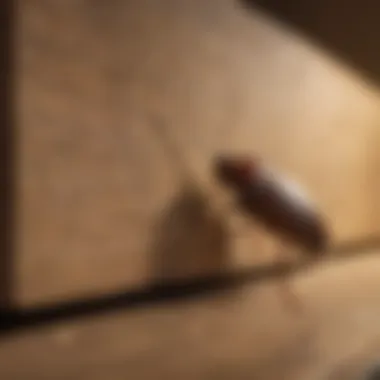

Physical Evidence
A key characteristic of physical evidence is its visibility. If you see frass or droppings, you might just find the wood roach has made its home nearby. These droppings, resembling small specks, often appear in areas where roaches are active. This is a priceless indicator, helping to pinpoint their presence before they establish a full infestation.
One unique feature of physical evidence, like discarded egg cases or shed skins, is that they serve as clues about a roach population's increase. Removing these indicators as soon as they are discovered is essential since they not only alert you to a potential infestation but can also further attract other pests.
Behavioral Signs
Beyond tangible signs, behavioral indicators offer insight into current wood roach activity. For example, spotting them during the day can indicate an intense activity level, unlike their nocturnal nature. If you see them when the sun is still up, it’s a signal that something’s not right.
The distinct ability of these critters to dart quickly when disturbed provides a unique way to recognize them. Such sudden movements can alarm homeowners, ultimately leading to quick action before they multiply. Keeping tabs on these signs can not only help in catching a budding infestation but also keeps you well-informed about their behavior.
Conditions Favoring Infestation
Next up is understanding the conditions that favor wood roach infestation. Knowing these helps in seting your home up for better protection.
Moisture Presence
Moisture is like a red carpet for wood roaches. They thrive in damp places, making it crucial to control humidity levels indoors. A significantly high percentage of moisture can create the perfect environment for them to flourish. Regular checks in places like basements and bathrooms are wise, since assessing dampness frequently can help in maintaining an inhospitable environment.
The unique feature here lies in the need for moisture in their habitat. If your environment tends to sit on the fewer moisture end, the chances of them sticking around diminish. Keeping your home dry not only hampers roach activities but also improves overall home health, reducing the likelihood of other household pests as well.
Environmental Factors
Environmental factors also play a major role in inviting wood roaches into the home. Warmth and availability of food sources are essential for these critters. They tend to prefer dwelling close to their food, like decaying wood or leaf litter. So, peeking around in your yard and outside areas can reveal if there's a potential roach breeding ground lurking nearby.
The ability of environmental factors to influence infestation significantly emphasizes the need for regular upkeep in outdoor spaces. Staying vigilant about debris and wood piles near your home provides an easy way to minimize your risk. Clear up any such areas quickly before they serve as an all-you-can-eat buffet for any wood roach lurking about.
Ultimately, understanding wood roach infestation plays a pivotal role in early detection and effective control, arming homeowners with the necessary knowledge to keep these nuisances at bay.
By keeping these indicators and conditions in mind, homeowners can develop a proactive approach that includes regular checks and immediate actions, helping to ensure that any infestation remains a distant memory.
Prevention Strategies
Preventing wood roaches from infiltrating your home is a vital part of residential pest control. This section aims to shed light on effective strategies that homeowners can employ to restrict the entry and survival of these pests. By taking proactive measures, individuals can not only avert infestations but also maintain a healthier living environment. Understanding the intricacies of prevention can save time and resources down the line.
Environmental Modifications
Reducing Moisture Levels
Wood roaches are notorious for gravitating towards damp environments, making reducing moisture levels a crucial first step in prevention. By addressing moisture issues, homeowners vastly decrease the attractiveness of their homes to these pests. Key characteristics of this approach include:
- Identification of moisture sources: Common culprits may include leaky pipes, poor drainage, and high humidity levels.
- Installation of dehumidifiers: This tool can be especially effective in basements and crawl spaces, ensuring that moisture remains low.
A unique feature of reducing moisture is its multifaceted benefits. Not only does it create an unwelcoming atmosphere for roaches, but it also enhances indoor air quality. However, it requires diligence and may involve initial investments for equipment installation and repairs.
Sealing Entry Points
Another essential tactic in preventing wood roach infestations is sealing entry points. This involves closing off access paths that pests could use to invade your home. Here’s why this method is popular among homeowners:
- Protection against various pests: While primarily focused on wood roaches, this strategy helps deter other insects and small animals as well.
- Simplicity and effectiveness: A door sweep or caulking can make a significant difference swiftly.
The unique aspect of sealing entry points lies in its immediacy; it provides instant protection that can feel rewarding. Though not every point can be completely sealed due to structural elements, ensuring the most vulnerable areas are covered can go a long way.
Regular Inspections
Regular inspections serve as an ongoing preventative measure against wood roaches. Performing these inspections can help catch any potential infestation in its early stages. Homeowners should look for:
- Signs of droppings or shed exoskeletons that might indicate roach activity.
- Routine checks in areas with high humidity and other food sources, such as kitchens and bathrooms.
Even a bi-monthly glance can enhance the security of your home, allowing for timely action if wood roaches do attempt an intrusion.
"An ounce of prevention is worth a pound of cure."
Overall, employing these prevention strategies can significantly enhance a homeowner’s ability to manage wood roach populations effectively. Each step, from reducing moisture to regular checks, builds a collective shield against the unwanted guests.


Treatment Options for Infestations
Addressing the presence of wood roaches in a home is crucial. Knowing how to effectively treat an infestation not only helps maintain a clean environment but also safeguards the health of all inhabitants. Infestations can quickly escalate if left unchecked. Residents may be overwhelmed or frustrated, thus it is key to understand the available methods for treatment. This section focuses on both at-home solutions and the expertise offered by professionals, providing a balanced overview of what options homeowners can assess.
DIY Control Methods
Boric Acid Applications
Boric acid is often touted as a classic in pest control. This versatile compound acts as both a poison and a desiccant. When wood roaches ingest it, it disrupts their digestive systems—leading to their demise quite effectively. One of its key characteristics is that it's relatively low in toxicity to humans and pets if handled properly, making it a less hazardous option for households. Common usage involves sprinkling the powder in areas where roaches are spotted or suspected to travel, such as under sinks or around plumbing fixtures.
However, using boric acid comes with its unique set of considerations. It can be absorbed through the skin or come into contact with food if not applied carefully. Thus, it’s essential to read the manufacturer's instructions and apply it judiciously. Overall, it's a beneficial approach for those who wish to address minor infestations without immediate recourse to chemical sprays or traps.
Traps and Baits
Traps and baits are another effective DIY method for dealing with wood roach infestations. These devices entice roaches, ultimately trapping or poisoning them. Sticky traps capitalize on the roach's natural curiosity in search of food and shelter. One advantage is visibility; they help homeowners identify hotspots within their homes where roach activity is concentrated.
Baits, on the other hand, often contain a baiting agent paired with a slow-acting poison. This combination is noteworthy because it allows roaches to carry the toxic substance back to their nest, potentially eliminating multiple individuals. The downside, however, is that traps can accumulate a range of insects, and baits might take time to show results, so patience is required.
Professional Pest Control Services
When the situation escalates beyond a manageable level, turning to professional pest control services may be the way to go. These experts bring a wealth of knowledge and resources that goes far beyond off-the-shelf treatments. Professionals conduct thorough inspections to pinpoint infestations and create customized treatment plans that target the specific circumstances of the home environment.
Moreover, their methodologies often include advanced techniques and professional-grade treatments that might not be accessible to general consumers. This consideration is particularly beneficial for those who have health concerns or issues related to chronic infestations. However, engaging a service can come with costs and may require some coordination. Weighing these factors carefully is paramount, ensuring that the investment leads to lasting results.
In summary, whether choosing to address an infestation through DIY methods or seeking help from professionals, understanding these treatment options is critical. Consider the needs of your household and the extent of the problem to select the most effective course of action.
Finale
Understanding wood roaches and their potential to infest homes is essential for effective pest management. This article brought to light key elements that can help homeowners identify, prevent, and treat infestations.
In summation, knowledge is power when it comes to these pests. Recognizing the signs of an infestation, such as the shedding of exoskeletons or droppings, can make a significant difference. Being aware of the conditions that favor their presence, like moisture and dark hiding spots, assists homeowners in taking proactive measures.
One important aspect covered here is the value of environmental modifications. Keeping areas dry and sealing off entry points not only helps thwart wood roaches but other pests too. Regular inspections create a layer of assurance; catching any potential problems early on means avoiding bigger issues down the line.
"An ounce of prevention is worth a pound of cure."
From the DIY control methods discussed to knowing when to call in the professionals, homeowners are now equipped with a toolkit for dealing with infestations. Ultimately, the risks of not addressing a wood roach situation can lead to larger infestation problems and potential damage to household items.
Beyond treating any current pest issues, it's critical to foster a holistic understanding of these creatures. This does not solely aid in managing wood roaches but also enhances the overall living environment, ensuring it remains a comfortable and safe space for families.
Further Resources
When it comes to dealing with wood roaches, knowledge is power. Having access to well-curated resources can significantly ease the process of understanding and managing these pests in your home. This section highlights why further resources are crucial and what specific elements you should look for when seeking more information.
Importance of Further Resources
Further resources serve several purposes for homeowners grappling with pest issues. First and foremost, they provide in-depth knowledge beyond the basics covered in initial guides. Resources such as books, articles, and credible websites equip readers with the tools to identify, prevent, and control infestations confidently. By understanding the life cycle, habits, and preferences of wood roaches, one can craft a tailored action plan.
Additionally, these resources often include useful tips from experts, advice on selecting appropriate control methods, and insights into ecological impacts, which can factor into decision-making. By informing yourself using quality materials, you reduce the chances of mishaps that could come from misinformation.
Benefits of Using Further Resources
- Expert Insights: Gain perspectives from pest management professionals. They often share tips that aren't found in typical homeowner manuals.
- Updated Practices: The realm of pest control is continually evolving, with new techniques emerging. Current resources will reflect these changes.
- Support Networks: Access to forums or community pages can provide reassurance. You’ll find others facing similar challenges and can share advice.
- Detailed Techniques: Many resources provide step-by-step instructions for dealing with infestations, whether through DIY methods or hiring professionals.
Considerations About Further Resources
- Credibility: Ensure that the sources consulted are reliable. Peer-reviewed articles or guides from reputable pest control organizations are better than random blogs.
- Relevance: Look for materials that specifically address wood roaches, as treatments can vary greatly depending on the species.
- Accessibility: Some resources may be behind paywalls or inaccessible in your region. Try to find those that offer free materials without compromising quality.
In summary, further resources can be your best ally against wood roaches. They equip you with the knowledge needed to tackle pest management effectively, thereby making your living environment more comfortable.
Recommended Reading
- "Pests and Their Management" by Steven M. Wilson - A comprehensive guide detailing various household pests, including wood roaches.
- "Home Pest Control" - A practical book filled with handy tips and tricks to keep your home pest-free.
- Local extension services publications - Often provide tailored strategies suited to your area, focusing on native pest species and environmental challenges.
Relevant Organizations and Websites
- National Pest Management Association (NPMA) - Offers a wealth of information about various pests and effective management strategies.
- American Roach Control Association - Focused specifically on roaches, including wood roaches, it provides advice, research, and the latest news around control measures.
- Your local university's agricultural extension website - Typically provide region-specific pest management information relevant to homeowners.
Always keep an eye on the latest educational materials, as wood roach infestations can be managed more successfully when armed with up-to-date knowledge.








